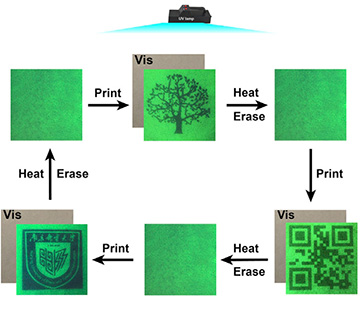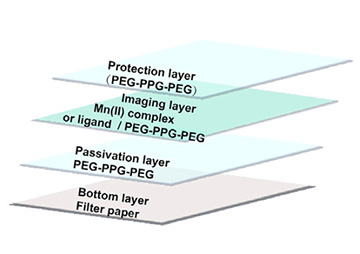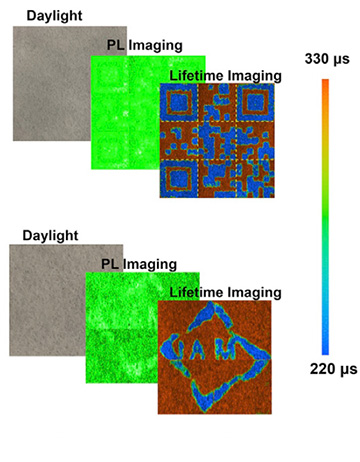
Researchers in China have devised a security paper on which images can be printed invisibly with water, recovered with UV light, and erased with heat from a blow dryer. [Image: P. She et al., Matter, doi: 10.1016/j.matt.2019.08.016 (2019) / Cell Press media office]
“Invisible ink” is a staple of spy novels, and increasingly plays a (fittingly) hidden role in real-world document security for military and business applications. A research team in China now reports a different spin on this security approach—one in which the invisible “ink” is plain water (Matter, doi: 10.1016/j.matt.2019.08.016).
The secret to the system is some clever chemistry that embeds luminescent manganese ion complexes into a reusable paper surface. Water, used as ink in a conventional inkjet printer, destroys the ionic coordination of the complexes, quenching their luminescence—which can be switched on again to read the message only under a specific wavelength of UV light.
The researchers note that the messages on the paper can be erased by simple heat treatment, allowing one sheet to be wiped and rewritten many times. And, for more sophisticated and sensitive military and economic security applications, the chemistry can be dynamically tweaked so that the paper can be decoded only by photoluminescence lifetime imaging (PLIM) under a hard-to-crack security protocol, according to the team.
Paper-based security
Notwithstanding the digital revolution, much sensitive information is still kept on paper, and researchers have devised a variety of fluorescent inks for security-conscious applications. Most such inks are non-erasable, however, and tend to be environmentally unfriendly. Moreover, fluorescent inks generally offer only skin-deep security and are easily cracked, making them an imperfect solution for highly secure communications.
To get around these limitations, a research team led by Wei Huang at the Nanjing University of Posts and Telecommunications, China, zeroed in on a particular chemical species—divalent manganese ion [Mn(II)] complexes, a family of luminescent substances that has already proved its mettle in applications such as organic LEDs. The team knew that the optical properties of this abundant, low-toxicity ion complex could be changed by exposure to a polar solvent, such as water, and that the reaction could be heat-reversed. That opened up the possibility for using ordinary H20 as invisible “ink” on reusable security paper.
UV-light decoding

[Image: P. She et al., Matter, doi: 10.1016/j.matt.2019.08.016 (2019) / Cell Press media office]
As a proof of concept, the team fashioned a four-ply paper prototype consisting of a layer of filter paper; a polymer passivation layer; a thin-film imaging layer embedded with MnCl42– ions, attached to sensitizing phosphate ligands; and a polymer protective layer on top. The team then ran the samples through an ordinary inkjet printer, using water as the ink.
The water, permeating through the protective layer, breaks the coordination between the Mn(II) ion complex (the emitter) and the phosphate complex (the sensitizer) in the imaging layer, thereby quenching the complex’s luminescence and encoding the image written by the water jet. The image remains invisible to the naked eye because, according to the team, “the reflective UV-visible spectroscopy of the security paper and the water-printed areas are almost the same.” Exposure to narrowband 254-nm UV light, however, re-excites the Mn(II) complex to emit and reveal the printed image.
The team found that the ionic coordination could be re-established, and the message thereby erased, by heating the paper with a blow dryer for 15 to 30 seconds—making it ready to encode another message. Tests by the team suggested that the paper was rewritable across at least 30 such cycles. And encoded messages remain readable for more than three months.
Tweaking emission lifetimes
While a neat parlor trick that might work in relatively low-security applications, the system using water as invisible ink immediately prompts an objection: Anyone with the right UV lamp can presumably decode the message. The team believes that this objection can be overcome, for high-security applications, via a different system that adds photoluminescence lifetime imaging (PLIM) to the mix.

By using inks with different magnesium–halide salts, the team was able to create a system in which images were invisible under both visible and UV illumination, but revealed under a photoluminescence lifetime imaging microscope. [Image: P. She et al., Matter, doi: 10.1016/j.matt.2019.08.016 (2019) / Cell Press media office]
It turns out that the emission lifetime of the Mn(II) complex can be “finely tuned over a wide range” by varying the halide ions around the manganese in the complex—for example, using species such as MnBr42–, MnI42–, and MnBr2Cl22– in addition to MnCl42–. To put that finding to use, the team created a different security paper that was impregnated with phosphate ligands that would grab onto these different Mn(II)–halide complexes.
The team then printed on this paper using custom inks containing mixtures of Mn(II)–halide salts. Because of the different emission lifetimes of the different Mn(II) complexes in the inks, the images could not be read under either visible or UV light, but could be revealed only with sophisticated PLIM analysis.
That extra security layer, according to the scientists, “protects the printed confidential information from general decryption methods.” And the researchers believe that the emission-lifetime-based approach involving multiple halide salts allows sufficient dynamic control to serve as a foundation for multi-level paper-document security suitable for defense applications.
